PCT Yearly Review: Developments and Performance
[ PDF Version ]
- PREFACE
- 1. HIGHLIGHTS
- 2. FILINGS OF PCT APPLICATIONS
- 3. ANALYSIS OF PCT APPLICANTS
- 3.1 Top 15 Countries of Origin
- 3.2 Indicators of Internationalization
- 3.3 PCT and Developing Countries
- 3.4 Top 20 PCT Applicants
- 3.5 Foreign Inventors named in PCT International Applications
- 3.6 Publications by Field of Technology
- 3.7 PCT National Phase Entries by Country of Origin and Designated/Elected Office
- 4. ANALYSIS OF PCT APPLICATIONS
- 5. PERFORMANCE OF THE INTERNATIONAL PATENT SYSTEM
- 6. ELECTRONIC ENVIRONMENT AND THE PCT
- 7. DISSEMINATION OF PCT AND PATENT INFORMATION
- 8. DEVELOPMENTS RELATED TO THE PCT LEGAL FRAMEWORK
- 9. STATISTICAL TABLE
- 10. GLOSSARY
- 11. PCT CONTRACTING STATES
- 12. MORE RESOURCES ON THE INTERNET
PREFACE
About the Patent Cooperation Treaty
The Patent Cooperation Treaty (PCT), which entered into force in 1978, offers inventors and industry an advantageous route for obtaining patent protection internationally. By filing one “international” patent application under the PCT, protection of an invention can be sought simultaneously in each of a large number of countries. Both applicants and patent Offices of the 139 PCT Member States benefit from the uniform formality requirements, the international search and preliminary examination reports and from the centralized international publication. The national patent granting procedure that follows, and the related expenses, are postponed, in the majority of cases, by up to 18 months from the priority date (or even longer in the case of some Offices) as compared with the traditional patent system. At the end of this period, the applicant should have received important value-added information concerning the likelihood of obtaining patent protection..
The graph below shows an overview of the main processing stages of patent applications within the international phase of the PCT system and their related timelines.
Overview of the PCT System
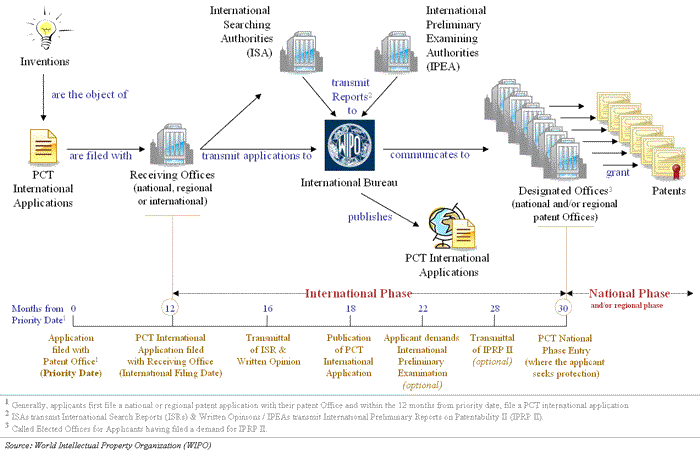
- An applicant using the PCT system must file a PCT international application at a receiving Office and choose an International Searching Authority that will provide him with a report and a written opinion on the patentability of his invention. The International Bureau of the World Intellectual Property Organization (WIPO) then publishes the application and communicates all necessary documents to patent Offices party to the PCT system. The applicant can choose to file a demand for a second evaluation of the patentability of his invention with an International Preliminary Examining Authority. The applicant has, in general, 30 months from the priority date to enter the PCT national phase in countries or regions in which he seeks protection.
PCT filing
A patent applicant who wishes to protect his invention in more than one country using the PCT system should file an international application under the PCT with a competent receiving Office. Generally, applicants first file a patent application with their patent Office and, within 12 months from the priority date, file their international application under the PCT.
International Bureau
The receiving Office transmits a copy of the PCT international application to the International Bureau (IB) of WIPO. The IB is responsible for:
- receiving and storing all application documents;
- performing a second formalities examination;
- publishing the application and related documents on PATENTSCOPE® search service;
- translating the title and abstract of the PCT international application and certain associated documents into English and/or French, where necessary;
- communicating documents to Offices and third parties;
- providing legal advice on request to users; and
- providing PCT-related assistance to PCT member States.
The applicant is required to pay an international filing fee of 1,330 Swiss Francs (CHF) and where the PCT international application contains more than 30 pages, an additional fee per sheet of CHF 15 (a fixed rate applies in some cases). Up to CHF 300 in fee reductions are available to applicants who file electronically. A 90% reduction in the international filing fee (including the fee per sheet over 30) and the handling fee (see “International Preliminary Examination” below), as well as an exemption from the transmittal fee payable to the International Bureau as the receiving Office, is also available to certain applicants (see section 8.1.1).
International Search
The PCT international search is carried out by a patent Office appointed to act as an International Searching Authority (ISA), within the PCT minimum documentation prescribed in the Treaty. The International Search Report (ISR) contains a list of documents with indications of relevance to the patentability, namely novelty and inventive step (non-obviousness). In addition, the ISA establishes a written opinion which contains a detailed analysis of the patentability of the invention.
The ISR and the written opinion are communicated by the ISA to the applicant normally by the fourth or fifth month after the PCT international application has been filed. Applicants are required to pay a search fee which varies from approximately CHF 328 to 2,7261 according to the ISA chosen.
International Preliminary Examination
The international preliminary examination is an optional procedure where a second evaluation of the patentability of the invention can be sought from the International Preliminary Authority (IPEA).
The preliminary examination fees vary from approximately CHF 231 to 2,526 depending on the IPEA (and the ISA) chosen. A handling fee of CHF 200 also applies.
PCT National Phase
An applicant who has decided to proceed further with his PCT international application must, before the end of the 30th month from the priority date (or even longer in the case of some Offices), fulfill the requirements for entry into the PCT national phase at the patent Offices of or acting on behalf of States in which he seeks protection. The national or regional patent Offices concerned then begin the granting procedure under the national laws. In addition to paying the official fees, the applicant usually needs to appoint local agents and have the application translated.
By using the PCT system, in addition to important value-added information concerning the likelihood of obtaining patent protection, a PCT applicant saves time and delays costs, i.e. the work performed during the international processing is generally not repeated at each Office and legal and translation costs are postponed.
Statistical Sources
The statistics in this annual review are based on two sources of data. For the international phase of the PCT System, data originate from the WIPO statistical database. Estimates have been made due to the fact that WIPO continues to receive PCT international applications filed in 2008 after the publication of this review.
For the national phase of the PCT System, statistics are based on data supplied to WIPO by national and regional patent Offices, received at WIPO often 6 months or more after the end of the year concerned, meaning that the latest available year to date is 2007. In some cases, PCT national phase entry data provided by the PATENTSCOPE® search service have been used. Data may be missing for some Offices or incomplete for some countries of origin. No estimates are made in this publication for the data concerning national phase.
The figures shown in this review are thus subject to change.2
Readers are welcome to use the information provided in this review, but are requested to cite WIPO as the source. Tables and graphs can be downloaded in image format at https://www.wipo.int/ipstats/en/statistics/pct/.
1 Highlights
In 2008, the international patent system saw several notable developments.
- Increase in the number of PCT Filings - The number of PCT international applications filings grew by 2.3% in 2008, to 163,600 applications. While the growth rate is modest, as compared to an average 9.3% growth rate in the previous three years, the total number of PCT international applications filed in 2008 represents the highest number of applications received under the PCT in a single year. The largest number of PCT international applications filed originated from applicants of the United States of America (53,521 applications).
- Some Countries show Robust Growth Rates - Applicants from the Republic of Korea (+12.0%), China (+11.9%) and Sweden (+12.5%) showed robust growth rates in their filing of PCT international applications in 2008.
- Changes in Top Applicants List - For the first time, a Chinese company topped the list of PCT applicants in 2008. Huawei Technologies Co. Ltd, a major international telecommunications company based in Shenzhen, had 1,737 PCT international applications published in 2008. Panasonic Corporation (Japan) was the second largest user of the PCT in 2008 with 1,729 international applications, followed by Koninklijke Philips Electronics N.V. (Netherlands, 1,551 PCT publications), Toyota Jidosha Kabushiki Kaisha (Japan, 1,364 PCT publications) and Robert Bosch GMBH (Germany, 1,273 PCT publications).
- Fields of Technology - The largest proportion of PCT applications published in 2008 related to medical technology (12.0%), computer technology (8.5%) and pharmaceuticals (7.9%) sectors. The fastest growing technology areas are information technology methods for management (+22.7%) and micro-structures and nanotechnology (+20.7%) although the actual number of applications for this technology remains relatively low.
- Enhancements of the PATENTSCOPE® Search Service – Several enhancements have been made to the PATENTSCOPE® Search Service, such as a complete interface in Spanish, full-text search for Japanese data and additional PCT national phase data.
- Additional PCT Statistics – In addition to further downloadable statistical tables on the PCT, two new quarterly reports are published online since the beginning of 2008. These reports provide indications and analysis on the trends and performance of the PCT system.
- Fee Reductions - As of July 2008, the PCT international fee has been reduced by 5%. In order to encourage use of the PCT in developing countries, the international filing fee is now reduced by 90% for individual applicants (not companies) from an approved list of developing countries and by 90% for all applicants from least developed countries.
2 FILINGS OF PCT APPLICATIONS
2.1 PCT International Application Filing Trends
The graph below shows the number of PCT international applications filed since their inception in 1978.
PCT International Application Filing Trends

- In 2008 163,6003 PCT international applications were filed.
- Since 1978, the number of PCT international applications filed is 1,649,698.
The graph below shows the annual growth rate of PCT international applications filed since 1980.
PCT International Application Annual Growth Rates
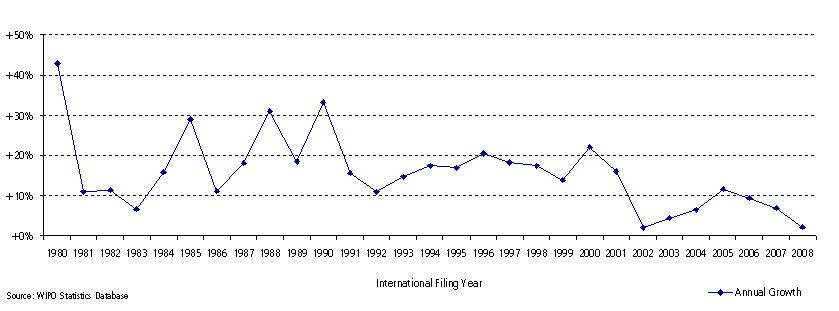
- In 2008 the growth rate over the previous year’s level was 2.3%.
2.2 PCT National Phase Entry Trends
The graph below shows the number of PCT national phase entries (including regional phase entries) since 1995. PCT national phase statistics illustrate the number of PCT international applications where applicants actually seek protection for their inventions in countries other than their country of residence. A PCT international application will often result in multiple national phase entries.
PCT National Phase Entry Trends
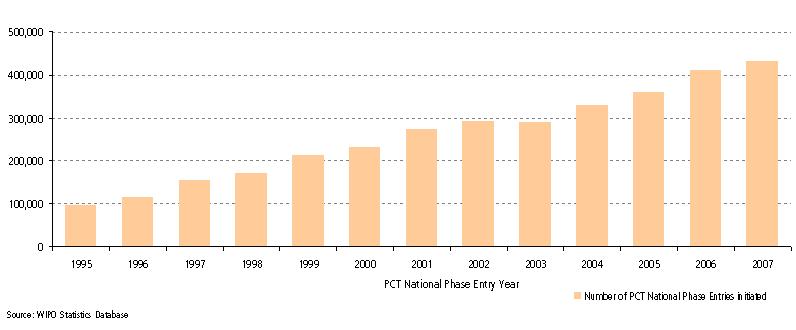
- In 2007, about 430,000 PCT national phase entries were initiated worldwide by applicants, following the PCT international phase.
The graph below shows the annual growth rate of PCT national phase entries since 1996.
PCT National Phase Entries Annual Growth Rates
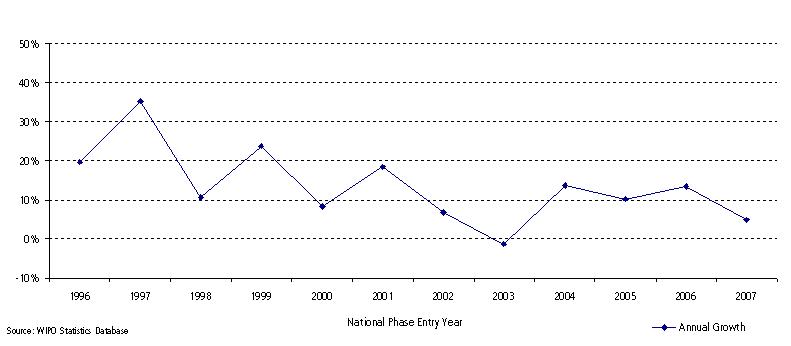
- In 2007, the number of PCT national phase entries increased by 5.1% over 2006.
3 ANALYSIS OF PCT APPLICANTS
3.1 Top 15 Countries of Origin
The table below shows the top 15 countries where applicants filed most PCT international applications in 2008. A statistical table containing all countries is available in the annex. The country of origin is taken to be the country of residence of the first-named applicant in the PCT international application.
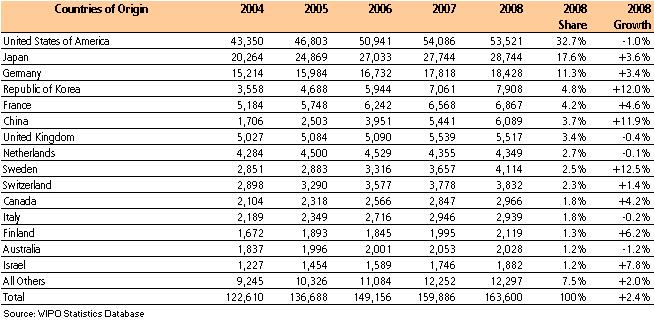
- China, Sweden, Canada and Finland gained one place over the previous year.
- The most significant increase in the number of filings originated from Sweden (+12.5%), the Republic of Korea (+12%) and China (+11.9%).
- In 2008, 80.3% of PCT international applications filed originated from the top 8 countries of origin.
- Together, the European Patent Convention Member States account for 55.879 PCT international applications, which is an increase of 3.7% over 2007.
3.2 Indicators of Internationalization
The table below shows, for the Top 50 countries of origin according to their number of PCT international applications (IAs) filed in 20084, the conversion rate of domestic (resident) filings into PCT international application filings and of PCT international application filings5 into PCT national phase entries (NPEs) before designated/elected Offices. It also shows the share of PCT national phase entries for each origin among the total number of foreign (non-resident) filings and among the total number of PCT national phase entries initiated worldwide.
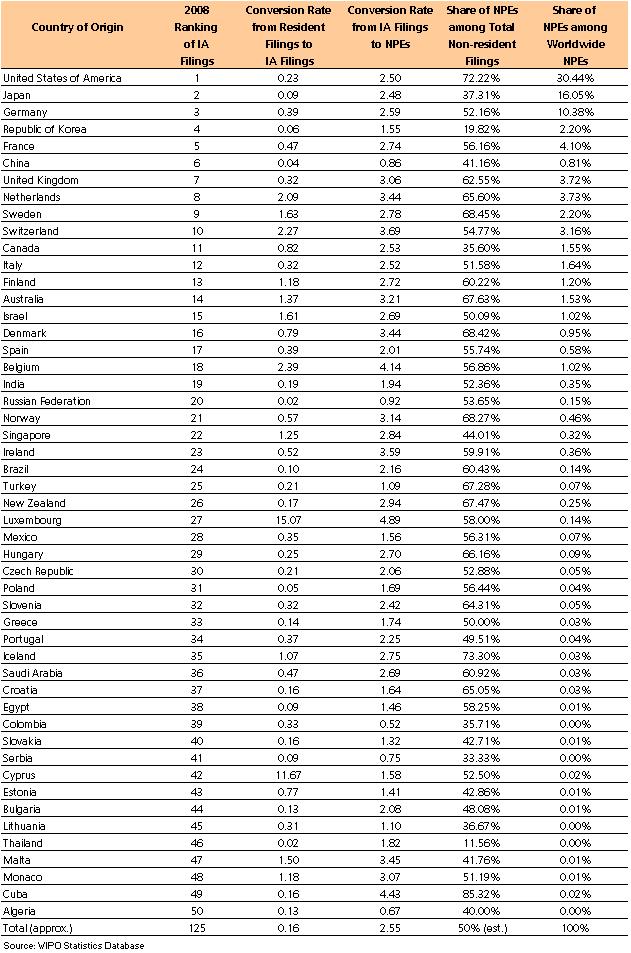
- As an example for understanding the table above, applicants from the United States of America file, on average, 0.23 PCT international applications per resident patent application filing and initiate 2.50 PCT national phase entries per PCT international application filing. Their proportion of PCT national phase entries among their total number of non-resident filings is 72.22%. Among all PCT national phase entries initiated worldwide, 30.44% originated from applicants from the United States of America.
- The share of PCT national phase entries among the total number of non-resident filings is very high for applicants from the United States of America (72.22%), States member of the European Patent Convention, Australia (67.63%), New Zealand (67.47%), Saudi Arabia (60.92%) and Brazil (60.43%). This share is relatively low for applicants from the Republic of Korea (19.82%), Canada (35.60%), Japan (37.31%) and China (41.16%).
- The conversion rate of resident filings to PCT international applications is very high for applicants from certain States member of the European Patent Convention (see footnote 5), Israel (1.61), Australia (1.37) and Singapore (1.25) and relatively low for applicants from the Russian Federation (0.02), China (0.04), the Republic of Korea (0.06) and Japan (0.09).
3.3 PCT and Developing Countries
The table below shows, among developing countries, the top 20 where applicants filed most PCT international applications in 2008.
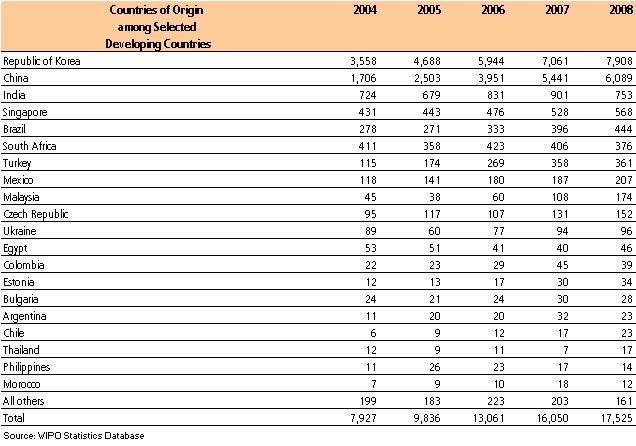
- As reflected in the statistical table in the annex, the number of PCT international applications filed by applicants from developing countries and least developed countries is low compared to the number of PCT national phase entries at their patent Offices.
3.4 Top 20 PCT Applicants
The table below shows the top 20 PCT applicants based on the number of PCT international applications published in 2008.
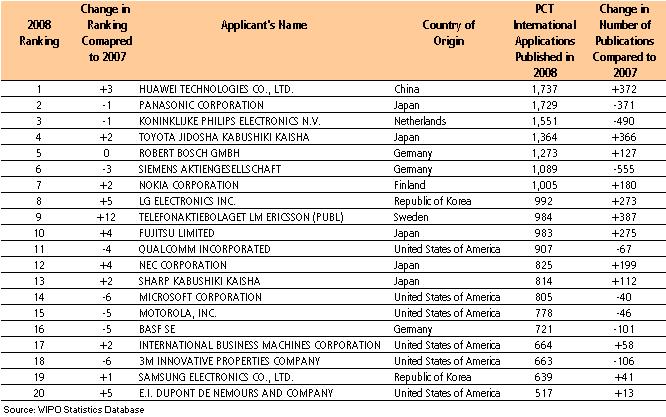
- The Chinese based company Huawei Technologies gained 3 places to 1st position with 1,737 PCT publications.
- The 3 main changes in ranking over the previous year originate from the Swedish based multinational Telefonaktiebolaget LM Ericsson (+12), the US Microsoft Corp. (-6) and the US 3M Innovative Properties Co. (-6).
- Of the top 100 companies using the PCT system in 20086, 38 were from the United States, 28 from Japan and 13 from Germany.
- In 2008, about 37,000 applicants and 276,000 applicants/inventors are named in published PCT international applications.
3.5 Foreign Inventors named in PCT International Applications
The graph below indicates the percentage of PCT international applications published in 2008 where at least one named applicant/inventor has a nationality different to the country of origin of the first named applicant. In a large majority of PCT filings, the first named applicant is a company.
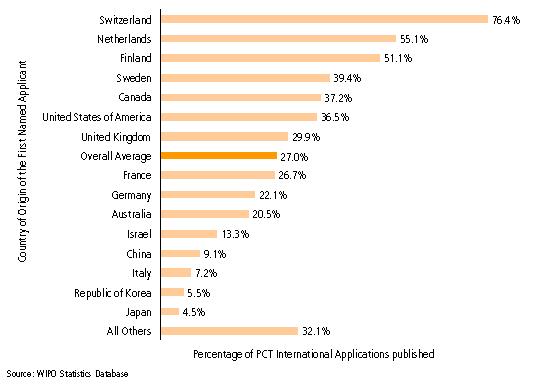
- Just over three-quarters of PCT international applications filed by a company based in Switzerland had at least one inventor that did not have the Swiss nationality.
- The percentage of foreign inventors named in PCT international applications filed by companies based in Japan (4.5%) or in the Republic of Korea (5.5%) is rather low compared to the overall average percentage (27%).
The graph below shows the number of foreign inventors named in PCT international applications filed in 2008, according to their nationality.
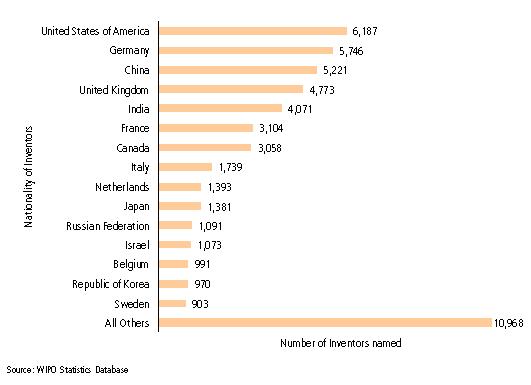
- In 2008, 6,187 citizens of the United States of America were named as inventors in PCT international applications filed by non-US based companies, representing 13.1% of the total number of foreign inventors.
- In total 47,339 foreign inventors were named in PCT international applications filed in 2008.
3.6 Publications by Field of Technology
The table below shows the fields of technology of PCT international applications published and the annual growth in 2008. In this table, PCT international applications are classified according to 35 classifications7 based on the latest version of the International Patent Classification system (IPC8). As a PCT international application can be assigned multiple IPC symbols that correspond to more than one field, the total count by field of technology is greater than the total number of PCT international applications published.
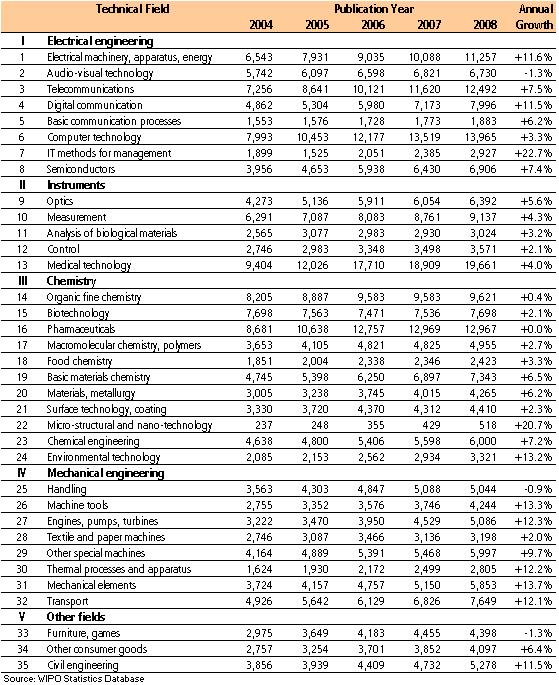
- The largest proportion of PCT applications published in 2008 related to the medical technology (12.0%), computer technology (8.5%) and pharmaceuticals (7.9%) sectors.
3.7 PCT National Phase Entries by Country of Origin and Designated/Elected Office
The table below shows the number of PCT national phase entries initiated in 2007 before designated and elected Offices according to the country of origin of the first named applicant.
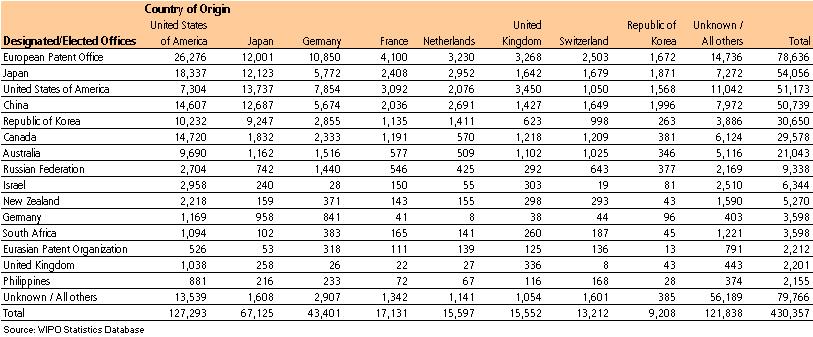
- With 78,636 PCT national/regional phase entries in 2007, the European Patent Office (EPO) is the most active designated/elected Office of the PCT system. Among them, 33.4% originated from the United States of America (26,276), 15.3% from Japan (12,001) and 13.8% from Germany (10,850).
- Almost 74% of PCT national phase entries originated from the eight countries shown in the above table. The top 7 designated/elected Offices received 75.5% of the total number of PCT national phase entries.
- A PCT applicant seeking protection in any of the States member to the European Patent Convention (see list in section 11) can generally choose between entering the national phase at a national Office or the regional phase at the EPO. As a result, the number of PCT national phase entries at some European national Offices is lower than would otherwise be expected.
- The PCT national phase route is closed for France, Italy, the Netherlands and several other EPC member States. A PCT applicant seeking protection in those countries must therefore enter the PCT regional phase at the EPO.
4 ANALYSIS OF PCT APPLICATIONS
4.1 Filings by Medium of Filing
The graph and table below show the changing distribution of filings on paper, on paper together with a diskette or other physical medium (CD-R, DVD-R) prepared electronically using the PCT-EASY functionality, or using fully electronic media since 2004. The fully electronic filings comprise XML and PDF filings as well as the United States Patent and Trademark Office web-based electronic filings (EFS-Web).
Share of PCT International Applications by Medium of Filing
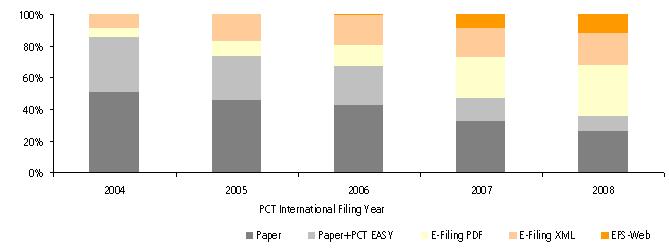

- In 2008, 64% of PCT international applications were filed using a fully electronic medium. If PCT EASY, the combined paper and electronic filing medium, is added to this figure, nearly three quarters (74%) of PCT international applications were filed in electronic form.
- The Canadian Intellectual Property Office announced it is prepared to receive and process PCT international applications in electronic form with effect from 29 September 2008, bringing to 21 the number of Offices which accept such filings.
4.2 Filings by Language of Filing
The table below shows the number of PCT international applications according to their language of filing. A PCT international application may be filed in any language accepted by the relevant receiving Office.
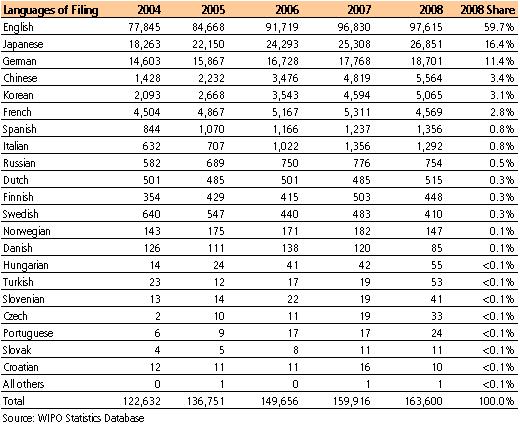
- English remains the main language of filing (59.7%).
- Compared to 2007, the ranking of the five most used languages of filing changed with the move of Chinese and Korean each up one to 4th and 5th place respectively, both overtaking French.
4.3 Publications by Language of Publication
The table below shows the number of PCT international applications published according to their language of publication. PCT international applications must be published in one of the official publication languages (Arabic, Chinese, English, French, German, Japanese, Russian and Spanish).
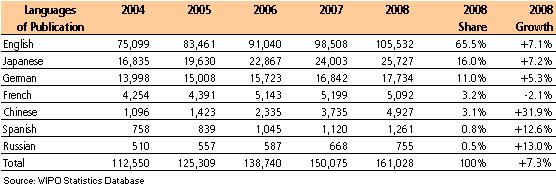
- The highest annual growth rates originate from Chinese (+31.9%), Russian (+13%) and Spanish (+12.6%).
4.4 PCT National Phase Entries by International Searching Authority
The table below shows the number of PCT national phase entries initiated by applicants before designated/elected Offices according to the International Searching Authority8. It shows the potential utilization of International Search Reports from each International Searching Authority at each designated/elected Office.
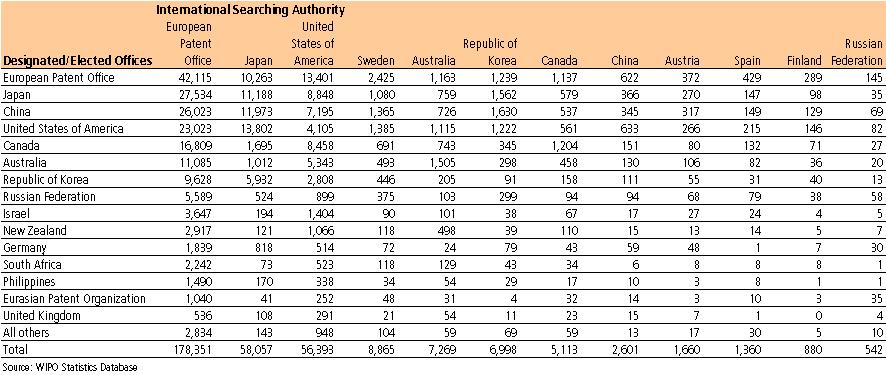
- The total count by International Searching Authority is greater than the number of International Search Reports established by International Searching Authority for PCT international applications filed in 2005 as one PCT international application can enter the PCT national phase at several designated/elected Offices.
The table below indicates the percentage of the total number of International Search Reports established by a given ISA of applications that entered the PCT national phase at a selection of designated/elected Offices. It also shows the global utilization rate of International Search Reports by International Searching Authority.
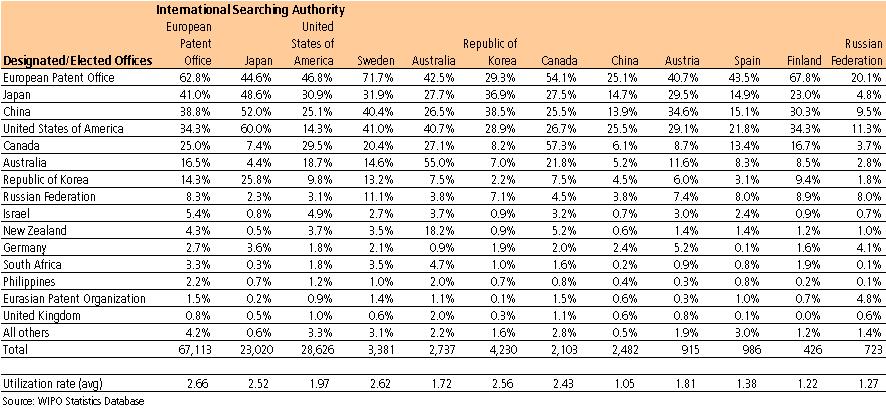
- As an example, 60% of PCT international applications filed in 2005 where the Japan Patent Office had been chosen by the applicant to act as the International Searching Authority entered the PCT national phase at the United States Patent and Trademark Office.
- The International Searching Authority having the highest utilization rate of its International Search Reports is the European Patent Office, with an average of one ISR used in 2.66 PCT national phase entries. The overall average is 2.40 PCT national phase entries per ISR.
5 PERFORMANCE OF THE INTERNATIONAL PATENT SYSTEM
5.1 Receiving Offices
PCT international applications are filed first with a receiving Office, which may be a national or regional Office or the International Bureau of WIPO. In 2008, 110 Offices were acting as receiving Offices
5.1.1 Top 15 Receiving Offices
The table below shows the Top 15 receiving Offices according to the number of PCT international applications filed. A statistical table containing all receiving Offices is available in the annex.
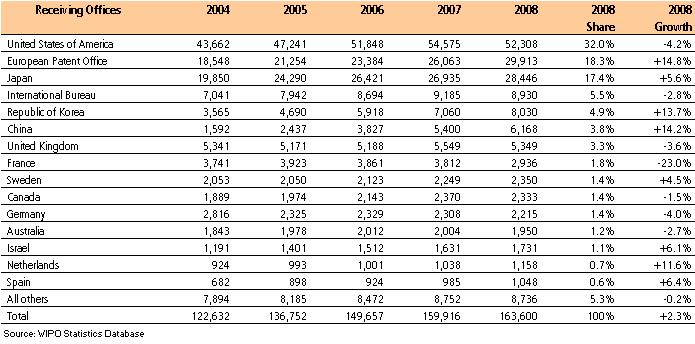
- The receiving Offices with the fastest growing numbers of PCT international applications filed in 2008 are the receiving Offices of the European Patent Convention (+14.8%), China (+14.2%) and the Republic of Korea (+13.7%).
- PCT international applications filed at the top five receiving Offices account for 78% of total filings in 2008.
5.1.2 Transmittal of PCT International Applications to the International Bureau as the Receiving Office
Where a PCT international application is filed with a receiving Office that cannot accept this application due to the nationality or the country of residence of the applicant, the language of filing or another reason, this application is forwarded to and considered as having been received by the International Bureau acting as the receiving Office9. In 2008, 1,118 filed PCT international applications were transmitted to the International Bureau as the receiving Office, which represents 0.7% of all PCT international applications filed that year.
5.2 International Bureau
In addition to its task as a receiving Office for applications from all PCT Contracting States, the International Bureau (IB) is responsible for the administration of the international phase of the PCT System.
5.2.1 Operations Workload and Personnel
The International Bureau of WIPO, through its PCT Operations Division, manages certain processing tasks with respect to all PCT international applications filed with all receiving Offices worldwide. Among others, these processing tasks consist of the following: formality examination, translation of abstracts and titles and publication of PCT international applications.
PCT Operations Workload and Personnel
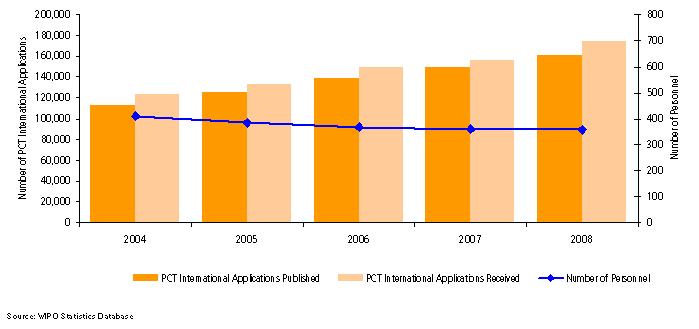

- Over the past four years, the number of PCT international applications received by the IB increased by 41% while the number of personnel processing PCT international applications decreased by 13%.
- A portion of the increase in productivity is accounted for by a growing share of outsourced translation work.
- The figure for PCT international applications received at the IB differs from that of applications published due to the fact that PCT international applications are usually published six months after their receipt by the IB.
5.2.2 Publication and Republication Timeliness
The PCT international application and related documents are published after the expiration of 18 months from the priority date unless the applicant requests early publication of the PCT international application or the application is withdrawn or considered withdrawn. At the time of publication, the International Bureau publishes the PCT international application even in the absence of an International Search Report (ISR). The PCT international application is republished together with the ISR after the latter arrives.
Publication
The graph below shows the timeliness of publication by the International Bureau of PCT international applications after the expiration of 18 months from the priority date.
Timeliness of the IB to publish PCT international applications
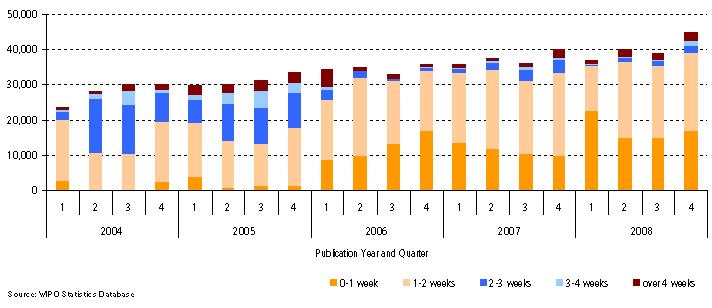
- In 2008, 91% of PCT international applications were published within two weeks following the expiration of 18 months from the priority date, 94% were published within three weeks and 95% within four weeks.
Republication
The graph below shows the timeliness of republication by the International Bureau of PCT international applications with ISRs in the cases where the ISR was missing upon publication.
Timeliness of the IB to republish PCT international applications with their ISR
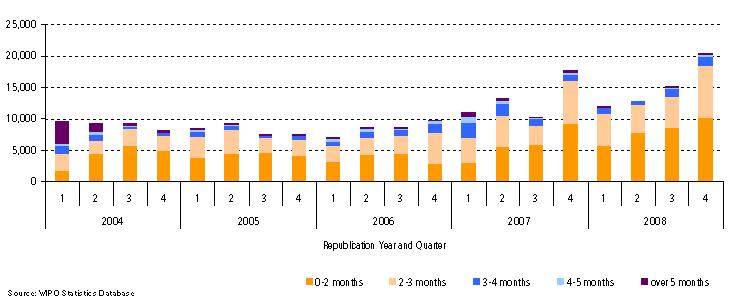
- In 2008, 53% of republications were published within two months of receipt of the ISR by the International Bureau, 91% within three months and 98% within four months.
5.2.3 Translation and Terminology
The objective of the International Bureau's translation work is to enhance the patent system's disclosure function by making the technological information embodied in PCT international applications accessible in languages other than those in which the original documents were filed. In order to meet this objective, the International Bureau translates and publishes all abstracts and titles of PCT international applications into English and French, and all reports (International Search Reports and International Preliminary Reports on Patentability) into English.
Given the high number of PCT filings, this represents a very significant translation workload which has evolved since 2006 as shown in the table below.

Most of these translations are now outsourced, a process involving 9 different agencies and about 10 external translators. In addition to producing translations internally, managing this entire outsourcing process with a budget of around CHF 15 million per year has become a principal responsibility of the International Bureau.
The graph below shows the distribution of internally produced and outsourced translations since 2006.
Distribution of Translation Work
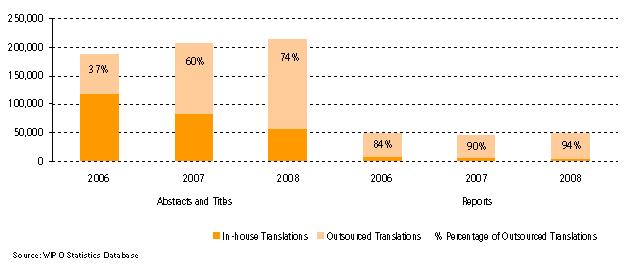
In 2008, the International Bureau began adjusting the language composition of its translation staff by hiring more linguists with Asian language skills with a view to ensure that, in the long-term, its staff composition reflects more adequately PCT filing patterns.
In recent years, the International Bureau has placed more emphasis on the introduction of information technology in the translation process. All outsourced translations are communicated to the external agencies through secure electronic channels. The International Bureau has also started the process of developing terminology databases that are aimed at improving the quality of internal and external translations and at supporting cross-language information retrieval in the PATENTSCOPE® search service. In 2008, it has looked more closely at the potential use of translation memories to improve quality and reduce cost. However, for this to be successful, the International Bureau will need to receive more documents requiring translation in character-coded format. This is particularly true for International Search Reports and International Preliminary Reports on Patentability.
5.3 International Search
International Searching Authorities (ISAs) are appointed by the PCT Assembly to carry out international searches. The Nordic Patent Institute started functioning as an ISA on 1 January 2008, bringing the number of national Offices or intergovernmental organizations which are acting as ISAs to 13 (two other Offices have been appointed as ISAs and IPEAs, but have not yet commenced operations). These Offices produce International Search Reports (ISRs) and the written opinions of the ISA. The ISR contains citations of documents considered to be relevant to the claimed invention (i.e. prior art), the classification of the subject matter of the invention and an indication of the fields searched as well as which electronic databases have been consulted. The ISR and the written opinion are communicated by the ISA to applicants normally by the fourth or fifth month after the PCT international application has been filed (16 or 17 months from priority date).
5.3.1 Distribution by International Searching Authorities
The chart below shows the number of PCT international applications filed according to their selected ISAs.
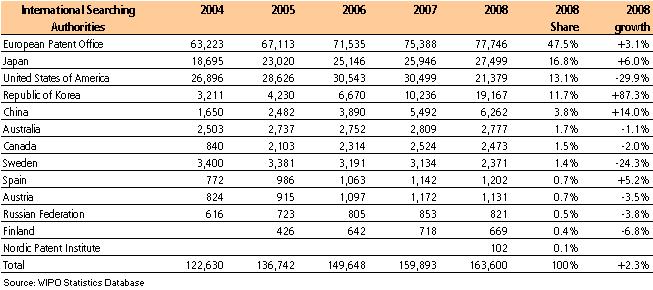
- The patent Offices acting as ISAs that experienced the largest growth rates compared to 2007 are the Offices of the Republic of Korea (+87.3%), China (+14%) and Japan (+6%).
- Since 2006, the Korean Intellectual Property Office has been acting as an International Searching and Preliminary Examining Authority for PCT international applications filed with the United States Patent and Trademark Office acting as the receiving Office.
5.3.2 Timeliness
The graph below shows the transmittal timeliness of ISRs to the International Bureau.
Timeliness to transmit International Search Reports
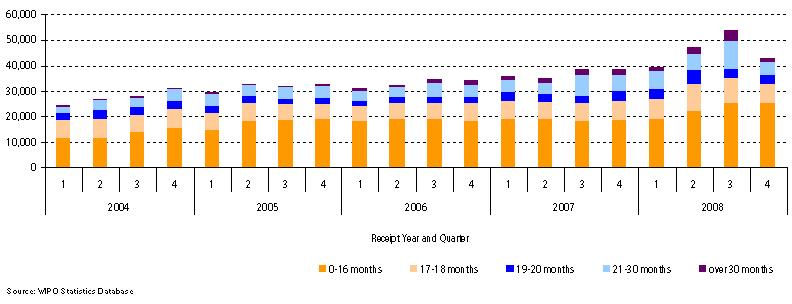
- In 2008, 50% of ISRs were received by the International Bureau before 16 months from the priority date and 22% after 20 months from the priority date.
5.4 International Preliminary Examination
International Preliminary Examining Authorities (IPEAs) are appointed by the PCT Assembly to carry out the international preliminary examination procedure. The Nordic Patent Institute started functioning as an IPEA on 1 January 2008, bringing the number of national Offices or intergovernmental organizations which are acting as IPEAs to 13. Their task is to establish the International Preliminary Examination Report (IPER) which is a preliminary, non-binding opinion, carried out at the request of the applicant, stating if the claimed invention appears to be novel, to involve an inventive step (to be non-obvious) and to be industrially applicable. As of 1 January 2004, this report is also known as the "international preliminary report on patentability (Chapter II of the PCT)". The IPER is communicated by the IPEA to applicants normally by the sixteenth month after the PCT international application has been filed (28 months from priority date).
5.4.1 Distribution by International Preliminary Examining Authorities
The graph below shows the number of demands for International Preliminary Examination since 2003. The decrease is due to a modification of the time limit for entry into the PCT national phase, in force since April 2002, and to the introduction in 2004 of the written opinion of the International Searching Authority that is now provided with the International Search Report for all PCT international applications.
International Preliminary Examination Demand Filing Trends
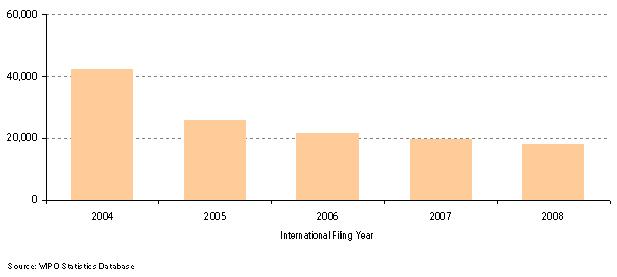
The table below shows the number of demands for International Preliminary Examination at each Examining Authority.
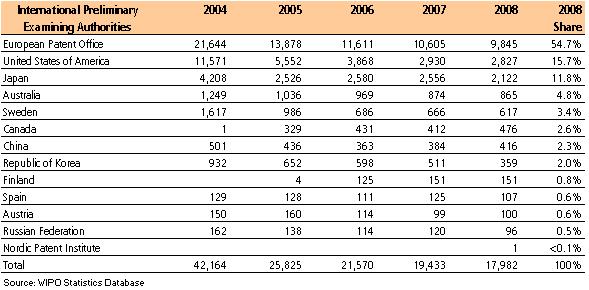
5.4.2 Timeliness
The data in the graph below shows the transmittal timeliness of IPERs to the International Bureau.
Timeliness to transmit International Preliminary Examination Reports
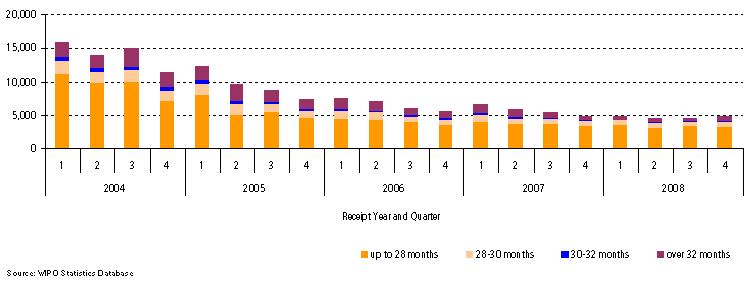
- In 2008, 70% of IPERs were received by the International Bureau before 28 months from the priority date and 13% after 32 months from the priority date.
6 ELECTRONIC ENVIRONMENT AND THE PCT
6.1 Electronic Filing
In 2008, 64% of all PCT international applications were filed fully electronically and the Canadian Intellectual Property Office announced its acceptance of fully electronic filings bringing the total to 21 Offices (see paragraph 4.1). Including the paper and electronic filing method, i.e. PCT EASY, 74% of PCT international applications were filed electronically in 2008.
Increased electronic filings and the receipt by the International Bureau of larger numbers of PCT documents in electronic format have contributed to the International Bureau’s ability to process more work with fewer staff (see paragraph 5.2.1). Apart from this general observation, electronic filings also impact other aspects of the International Bureau’s work as illustrated by the graphs below.
Most data input errors committed in 2008 by the International Bureau concern purely paper filings, whereas such errors are the least prevalent for fully electronic filings.
Percent Republications due to Input Errors in 2008
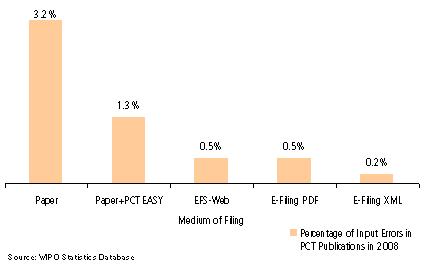
However, as illustrated by the graph below, the formality examination of XML filings by the International Bureau, on average, takes more time than that of the other filing formats, including paper. This is explained by the fact that the International Bureau’s procedures and systems have been designed to handle various document formats and, as yet, have not been optimized for XML. These procedures and systems as well as the medium of filing have, however, no negative impact on the timeliness to publish PCT international applications. It is to be expected that in the years to come, the International Bureau’s operational procedures, including those for translation, will be able to more fully exploit data and documents in character-coded format.
Timeliness to notify the Receipt by the IB of PCT International Applications by Medium of Filing
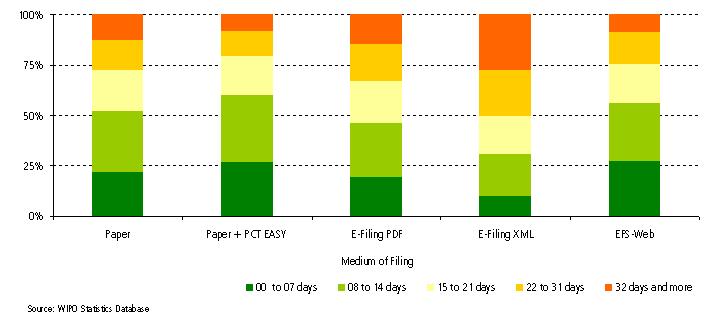
6.2 Electronic Exchange of Data between the International Bureau and Offices
Since 2007, the International Bureau receives about 80% of documents from Offices in electronic form which permits an increased internal efficiency by eliminating the need to scan a considerable volume of paper documents.
Due to this improvement in efficiency, the International Bureau would like to receive more of these documents, in particular the International Search Reports and the International Preliminary Reports on Patentability, in character-coded format because of the potential beneficial impact on its translation process and the ability to integrate them as fully text-searchable on the PATENTSCOPE® search service
6.3 Electronic Processing of PCT International Applications within the International Bureau
In 2008, the International Bureau capitalized further on fully electronic processing of PCT international applications as follows:
- The majority of the paper remaining in the International Bureau’s workflow now relates to communication with applicants. In an attempt to reduce this, and with a view to provide an improved service to PCT applicants, the International Bureau started in 2008 to send advanced electronic copies of PCT notifications by e-mail to applicants and agents who requested in this service.
- In 2008, the International Bureau also put in place the necessary IT infrastructure to set up a web-based service that will allow applicants to submit post-filing documents relating to their international applications to the International Bureau in electronic form by uploading them via a web interface. Internal testing of this document upload service was completed in 2008 and a pilot exercise with a restricted number of PCT users will start in the first quarter of 2009.
- In 2008, the International Bureau completed several iterations of development and testing of a new bibliographic data administration and management system to replace the current mainframe system, which has been in existence for the past 18 years. The operational deployment of the new system started in October 2008 and is scheduled to be completed during the first half of 2009.
7 DISSEMINATION OF PCT AND PATENT INFORMATION
7.1 PATENTSCOPE® Search Service
The PATENTSCOPE® search service provides access to the technology contained in over 1.5 million published PCT international applications since 1978. In 2008, a number of enhancements have been made to the PATENTSCOPE® search service, adding content, increasing the functionality of the service and making it more user-friendly.
The main changes are listed below:
- PATENTSCOPE® search service interface in Spanish. The PATENTSCOPE® search service interface is now available in Spanish in addition to English and French. The web pages available in Spanish include the search interface, search results, and all supporting web pages including on-line help pages.
- Full-text search for Japanese data. As of 3 July 2008, the PATENTSCOPE® search service supports keyword search in the Japanese language. The searchable Japanese text data includes the descriptions and claims of published PCT international applications filed electronically in Japanese and published on or after 3 July 2008, as well as all the titles and the majority of abstracts of PCT international applications published since 2004. This addition brings to six the number of languages in which full-text data search is possible; the other languages being English, French, German, Russian, and Spanish.
- PCT national phase information for Egypt and Poland. Thanks to the cooperation of the patent Offices of Egypt and Poland, the PATENTSCOPE® search service now includes PCT national phase information for Egypt and Poland. This addition brings to 34 the number of offices for which national phase information is now available10.
- Complete PCT file contents. For PCT international applications filed as of January 2009, the PATENTSCOPE® search service will provide free-of-charge access to the complete file contents of published PCT international applications (with the exception of confidential documents that the International Bureau of WIPO may not communicate). Since 2007, the PATENTSCOPE® search service has allowed users to retrieve, for all PCT international applications filed since January 2004, international search and examination reports and the English translations thereof as well as written opinions of the International Searching Authority and applicants’ informal comments on the written opinion. PCT request forms (PCT/RO/101) as well as notifications concerning the submission or transmittal of priority documents (PCT/IB/304) and notifications of the recording of a change (PCT/IB/306) can now also be viewed and downloaded through the PATENTSCOPE® search service.
7.2 New Internet Resources for PCT Users
The PCT Resources page now contains recent versions of all essential legal texts in 10 languages (Arabic, Chinese, English, French, German, Japanese, Korean, Portuguese, Russian and Spanish). Since January 2008, in addition to the regular updating of existing materials, the following new resources have been made available to users:
- The Arabic, Chinese, Korean and Russian versions of the PCT request form and the Korean and Russian versions of the demand form;
- The Arabic version of the Regulations under the PCT, and the Portuguese version of the Patent Cooperation Treaty and Regulations;
- The Russian version of the PCT International Search and Preliminary Examination Guidelines;
- Agreements between the International Bureau of WIPO and International Searching and Preliminary Examining Authorities in French, as well as English;
- PowerPoint presentations on the 2008 amendments to the PCT Regulations in Chinese, English, French, German and Korean;
- Annual reports on the quality management systems of International Searching and Preliminary Examining Authorities; and
- PCT Glossary in Russian
7.3 Aggregate Patent Statistics
In 2008, a number of enhancements have been made to the patent statistics compiled by WIPO:
- In the 2008 edition of the World Patent Report 11, which provides a range of statistics on PCT and direct patent activity for a broad range of countries, new sections have been added to provide statistics by patent families, by ownership type, on opposition and invalidation, and on the cost of patenting. Further improvements have also been made to patents statistics by fields of technology.
- A new IPC – field of technology concordance table, based on the latest version (version 8) of the International Patent Classification (IPC)12 , has been published on-line. The table is an update of formerly existing tables, such as the “OST, INPI and FhG-ISI” table. It is composed of 5 fields and 35 sectors (see table in paragraph 3.6)
- The PCT system statistics webpage has been completely renewed and now contains downloadable statistics and two on-line quarterly reports: The “Trends and Analysis” report which provides a core set of indicators on the latest trends in PCT filings and the “Performance Indicators” report which focuses on the performance of the PCT system by providing statistical information about the various stages of the PCT international application process.
8. DEVELOPMENTS RELATED TO THE PCT LEGAL FRAMEWORK
8.1 Amendments entering into force and other developments in 2008
8.1.1 Amendments to the Schedule of Fees
On 31 March 2008, an Extraordinary Session of the Assembly of the PCT Union approved the following amendments to the Schedule of Fees annexed to the PCT Regulations, which entered into force on 1 July 2008, and applied to any PCT international application which was received by the receiving Office on or after 1 July 2008:
(a) The international filing fee was reduced by 5%, from 1,400 to 1,330 Swiss francs.
(b) The reduction in the international filing fee and the handling fee which is accorded to applicants who meet the criteria indicated in Item 4(a)13 or (b)14 of the Schedule of Fees was increased from 75% to 90%.
(c) The scope of the fee reduction accorded to applicants from certain States was extended so that an applicant who was a natural person and who was a national of and resided in one of the following nine States also became entitled to the above-mentioned reduction in the international filing fee and the handling fee: Antigua and Barbuda, Bahrain, Barbados, Libyan Arab Jamahiriya, Oman, Seychelles, Singapore, Trinidad and Tobago, United Arab Emirates.
8.1.2 Amendments to PCT Regulations
Amendments to the PCT Regulations adopted by the PCT Assembly in September and October 2007 which entered into force on 1 July 2008:
(a) It became possible for applicants to request the International Searching Authority (ISA), when carrying out the international search, to take into consideration the results not only of an earlier search it has carried out, but also of an earlier search carried out by another ISA or a national or regional Office (amendment of PCT Rule 41.1 and the adoption of new Rules 4.12 and 12bis.1).
(b) It became possible for the receiving Office to extend, for a period of up to two months, the time limit for the payment of the fee for requesting restoration of the right of priority (amendment of PCT Rule 26bis.3(d)).
(c) Clarification was made to PCT Rule 29 that withdrawal of the PCT international application will only prevent international publication if the notice of withdrawal is received by the International Bureau prior to completion of technical preparations for international publication.
8.1.3 Other Developments
- Attaching pre-conversion files to international applications filed electronically. Following modifications to Part 7 and Annex F of the Administrative Instructions under the PCT, which entered into effect on 1 July 2008, it became possible for applicants, if the receiving Office so permits, to include the application documents in a pre-conversion format (together with the PCT international application) accompanied by a statement that the PCT international application as filed in electronic form is a complete and accurate copy of the document in pre-conversion format. In this way, should data have been accidentally modified or altered in the conversion process, the applicant has the opportunity to correct the PCT international application as filed so as to bring it into conformity with the copy of the PCT international application in the pre-conversion format.
- New possibility for applicants to receive notifications by e-mail. As from 1 July 2008, it became possible to include in the request form an e-mail address for the applicant or agent, and an authorization to be sent advance copies of notifications in respect of the PCT international application by e-mail, in addition to the normal paper forms sent by mail.
8.2 Changes in 2009
During the course of the Assembly of the PCT Union which was held in September 2008, the following amendments were agreed to the PCT Regulations:
Entry into force January 2009: in connection with the Regulations which had been adopted by the PCT Assembly at its session held in September/October 2007 relating to the supplementary international search service, which started on 1 January 2009, further amendments were made in September 2008 concerning: the right of agents to practice before any International Authority specified to carry out a supplementary international search; the effects of a withdrawal of a request for supplementary international search, and a clarification was made concerning the refund of the supplementary search fee and the supplementary search handling fee.
Entry into force July 2009: clarification of the procedure to be followed by the receiving Office where it has accorded, albeit mistakenly, an international filing date and intends to issue a declaration under PCT Article 14(4) that the PCT international application is to be considered withdrawn because it does not contain the claim(s) element or the description element; and, in the case of the submission of amendments of the claims under PCT Articles 19 and 34, applicants will be required to submit a replacement sheet or sheets containing a complete set of claims rather than, as at present, replacement sheets only for those sheets of claims which differ from sheets previously filed.
8.3 Meetings other than the PCT Assembly held in 2008
Meeting of International Authorities under the PCT
The Meeting of International Authorities under the PCT, which was held in Vienna at the Austrian Patent Office from 7 to 9 April 2008, discussed a number of issues, including:
- A report on the quality frameworks of all the Authorities
- A preliminary working paper proposed by the International Bureau entitled “Enhancing the Value of International Search and Preliminary Examination under the PCT”.
- The supplementary international search service – several Offices reported that they expected to be ready to offer this service from 1 January 2009, others indicated that it was likely that they would be able to offer such a service from 1 January 2010, while others indicated general support for the principle but were not in a position to report any provisional plans for offering such a service, and some Authorities had no plans to offer this service.
- The Common Application Format, which had recently been agreed upon by the Trilateral Offices (the European Patent Office, the Japan Patent Office and the United States Patent and Trademark Office).
8.4 PCT Training
In the course of 2008, the PCT Legal Division organized and participated in 84 seminars, presentations and workshops, where 5,194 people participated.
These events were held in the following countries: Canada, Czech Republic, Denmark, Germany, Finland, France, Iceland, India, Israel, Jordan, Norway, Oman, Republic of Korea, Singapore, Spain, Sweden, Switzerland, Thailand, United Kingdom, and United States of America.
9 STATISTICAL TABLE
The table below shows the number of PCT international applications filed in 2008 and the number of PCT national phase entries in 2007 by Office and by country and territory of origin. For PCT international applications filed, estimates have been made for the top 15 countries of origin and receiving Offices (see paragraphs 3.1 and 5.1.1). The figures shown in this table are thus subject to change15.
A PCT applicant seeking protection in any of the States member to the European Patent Convention (EPC)16 can generally choose between entering the national phase at a national Office or the regional phase at the European Patent Office (EPO). This explains why the number of PCT national phase entries at some European national Offices is lower than would otherwise be expected. The PCT national phase route is closed for France, Italy, the Netherlands and several other EPC member States (see section 11). A PCT applicant seeking protection in those countries must enter the PCT regional phase at the EPO.
As an example for understanding the table below, the Algerian patent Office received 9 PCT international application filings in 2008 and 734 PCT national phase entries in 2007, whereas applicants residing in Algeria filed, worldwide, 11 PCT international applications in 2008 and 2 PCT national phase entries in 2007.
| Name | Code | PCT International Phase Filings in 2008 | PCT National Phase Entries in 2007 | ||
|---|---|---|---|---|---|
| At Receiving Office | By Country of Origin | At Designated /Elected Office | By Country of Origin | ||
| Afghanistan | AF | 1 | |||
| African Intellectual Property Organization | OA | 1 | |||
| Algeria | DZ | 9 | 11 | 734 | 2 |
| Andorra | AD | 5 | 3 | ||
| Antigua and Barbuda | AG | 1 | |||
| Argentina | AR | 23 | 44 | ||
| Armenia | AM | 5 | 6 | 5 | |
| Australia | AU | 1,948 | 2,028 | 21,043 | 6,419 |
| Austria | AT | 475 | 923 | 465 a | 2,484 |
| Azerbaijan | AZ | 2 | 1 | 11 | |
| Bahamas | BS | 21 | 87 | ||
| Bahrain | BH | 3 | |||
| Barbados | BB | 134 | 681 | ||
| Belarus | BY | 7 | 9 | 36 a | 20 |
| Belgium | BE | 105 | 1,087 | 4,279 | |
| Belize | BZ | 3 | 33 | ||
| Benin | BJ | 1 | |||
| Bosnia and Herzegovina | BA | 8 | 10 | 160 a | 2 |
| Brazil | BR | 410 | 444 | 18,057 a | 585 |
| Brunei Darussalam | BN | 16 | |||
| Bulgaria | BG | 26 | 28 | 24 | 50 |
| Burkina Faso | BF | 1 | |||
| Burundi | BI | 2 | |||
| Cameroon | CM | 1 | 1 | ||
| Canada | CA | 2,331 | 2,966 | 29,578 | 6,498 |
| Chile | CL | 23 | 40 | ||
| China | CN | 6,163 | 6,089 | 50,739 | 3,391 |
| Colombia | CO | 39 | 1,747 | 15 | |
| Cook Islands | CK | 3 | |||
| Costa Rica | CR | 5 | 7 | 1 | |
| Croatia | HR | 40 | 55 | 62 | 121 |
| Cuba | CU | 11 | 12 | 210 | 93 |
| Cyprus | CY | 1 | 35 | 84 | |
| Czech Republic | CZ | 151 | 152 | 97 | 220 |
| Democratic People's Republic of Korea | KP | 7 | 7 | 68 | 16 |
| Democratic Republic of the Congo | CD | 2 | |||
| Denmark | DK | 774 | 1,306 | 33 | 3,982 |
| Dominican Republic | DO | 5 | 5 | 1 | |
| Ecuador | EC | 4 | 4 | 794 | 2 |
| Egypt | EG | 46 | 46 | 1,429 | 60 |
| El Salvador | SV | 3 | 3 | ||
| Estonia | EE | 26 | 34 | 11 | 24 |
| Eurasian Patent Organization | EA | 6 | 2,212 | ||
| European Patent Office | EP | 29,888 | 78,636 | ||
| Finland | FI | 956 | 2,119 | 78 | 5,016 |
| France | FR | 3,007 | 6,867 | 17,131 | |
| Gabon | GA | 1 | |||
| Georgia | GE | 7 | 10 | 74 | 5 |
| Germany | DE | 2,214 | 18,428 | 3,598 | 43,401 |
| Ghana | GH | 3 | 3 | ||
| Greece | GR | 71 | 106 | 3,873 | 146 |
| Grenada | GD | 1 | |||
| Guatemala | GT | 12 | 15 | ||
| Honduras | HN | 3 | |||
| Hong Kong (SAR), China | HK | 1 | 92 | ||
| Hungary | HU | 157 | 170 | 52 | 391 |
| Iceland | IS | 22 | 64 | 50 | 140 |
| India | IN | 702 | 753 | 15,467 b | 1,601 |
| Indonesia | ID | 6 | 10 | 14 | |
| International Bureau | IB | 8,931 | |||
| Iran (Islamic Republic of) | IR | 1 | |||
| Ireland | IE | 128 | 437 | 1,520 | |
| Israel | IL | 1,729 | 1,882 | 6,344 | 4,281 |
| Italy | IT | 821 | 2,939 | 6,852 | |
| Jamaica | JM | 1 | |||
| Japan | JP | 28,422 | 28,744 | 54,056 | 67,125 |
| Jordan | JO | 6 | 20 | ||
| Kazakhstan | KZ | 4 | 4 | 12 | |
| Kenya | KE | 1 | 1 | 30 a | 4 |
| Kuwait | KW | 3 | 1 | ||
| Kyrgyzstan | KG | 1 | |||
| Lao People's Democratic Republic | LA | 1 | |||
| Latvia | LV | 10 | 21 | 15 | |
| Lebanon | LB | 1 | |||
| Libyan Arab Jamahiriya | LY | 1 | |||
| Liechtenstein | LI | 393 | 188 | ||
| Lithuania | LT | 9 | 19 | 9 | 11 |
| Luxembourg | LU | 226 | 42 b | 587 | |
| Macau (SAR), China | MO | 2 | |||
| Madagascar | MG | 1 | 39 a | ||
| Malaysia | MY | 196 | 174 | 73 | |
| Malta | MT | 15 | 38 | ||
| Mauritania | MR | 2 | |||
| Mauritius | MU | 3 | 16 | ||
| Mexico | MX | 181 | 207 | 13,887 | 281 |
| Moldova | MD | 3 | 5 | 11 | 6 |
| Monaco | MC | 13 | 43 | ||
| Mongolia | MN | 3 | 101 a | 2 | |
| Morocco | MA | 9 | 12 | 455 b | 23 |
| Myanmar | MM | 1 | 3 | ||
| Netherlands | NL | 1,157 | 4,349 | 15,597 | |
| New Zealand | NZ | 354 | 309 | 5,270 | 1,031 |
| Norway | NO | 477 | 630 | 4,902 | 1,913 |
| Oman | OM | 13 | |||
| Pakistan | PK | 1 | |||
| Panama | PA | 10 | 50 | ||
| Peru | PE | 1 | |||
| Philippines | PH | 12 | 14 | 13 | |
| Poland | PL | 119 | 127 | 147 | 171 |
| Portugal | PT | 59 | 93 | 1 | 153 |
| Qatar | QA | 2 | |||
| Republic of Korea | KR | 8,024 | 7,908 | 30,650 | 9,208 |
| Romania | RO | 8 | 11 | 24 | 50 |
| Russian Federation | RU | 726 | 655 | 9,338 | 640 |
| Saint Kitts and Nevis | KN | 1 | |||
| Saint Lucia | LC | 1 | |||
| Saint Vincent and the Grenadines | VC | 1 | |||
| Samoa | WS | 3 | 11 | 2 | |
| San Marino | SM | 2 | 11 | 4 | |
| Saudi Arabia | SA | 60 | 145 | ||
| Senegal | SN | 1 | |||
| Serbia | RS | 37 | 36 | 54 | 6 |
| Serbia and Montenegro (formerly Yugoslavia) | YU | 17 | |||
| Seychelles | SC | 16 | 40 | ||
| Sierra Leone | SL | 1 | |||
| Singapore | SG | 503 | 568 | 7,414 | 1,351 |
| Slovakia | SK | 29 | 39 | 69 | 41 |
| Slovenia | SI | 72 | 106 | 191 | |
| South Africa | ZA | 117 | 376 | 5,781 a | 161 |
| Spain | ES | 1,052 | 1,263 | 93 | 2,407 |
| Sri Lanka | LK | 11 | |||
| Sudan | SD | 1 | 3 | ||
| Swaziland | SZ | 3 | |||
| Sweden | SE | 2,348 | 4,114 | 21 | 9,208 |
| Switzerland | CH | 560 | 3,832 | 7 | 13,212 |
| Syrian Arab Republic | SY | 5 | 5 | 2 | |
| T F Y R of Macedonia | MK | 1 | 2 | ||
| Thailand | TH | 17 | 4,616 a | 20 | |
| Trinidad and Tobago | TT | 8 | |||
| Tunisia | TN | 2 | 3 | 6 | |
| Turkey | TR | 147 | 361 | 199 | 292 |
| Turkmenistan | TM | 1 | |||
| Uganda | UG | 1 | |||
| Ukraine | UA | 76 | 96 | 2,102 a | 56 |
| United Arab Emirates | AE | 22 | 24 | ||
| United Kingdom | GB | 5,344 | 5,517 | 2,201 | 15,552 |
| United States of America | US | 52,306 | 53,521 | 51,173 | 127,293 |
| Uruguay | UY | 6 | 11 | ||
| Uzbekistan | UZ | 2 | 188 | ||
| Vanuatu | VU | 1 | |||
| Venezuela | VE | 2 | 4 | ||
| Viet Nam | VN | 4 | 6 | 5 | |
| Zambia | ZM | 1 | |||
| Other/Unknown | 302 | 3,987 | |||
a. 2006 data.
b. 2005 data
Source: WIPO Statistics Database
10 GLOSSARY
This glossary is mainly an extract from the PCT and PATENTSCOPE® glossaries .
Applicant. A person claiming to be the first and true inventor, or assignee of the first and true inventor of an invention. There may be one or more applicants. In the United States, the applicant(s) must be the inventor(s). For a PCT international application, at least one of the applicants must be any natural person or legal entity who is a national or resident of a PCT Contracting State. An applicant is sometimes known as an assignee or owner.
Chapter I of the PCT. The chapter of the PCT that regulates the filing of the international application, international search, establishment of the written opinion of the International Searching Authority, international publication of the international application, and provides for the communication of the international application and related documents to designated Offices.
Chapter II of the PCT. The chapter of the PCT that regulates the optional international preliminary examination procedure and provides for the communication of the International Preliminary Examination Report and certain related documents to elected Offices. A demand may be filed by the applicant to enter Chapter II. If no demand is filed, the application remains in Chapter I.
Country of Origin. For statistical purposes, the country of residence of the first-named applicant or assignee of a patent application. Country of origin is used to determine the origin of the patent application.
Demand. A demand (on Form PCT/IPEA/401) by the applicant for international preliminary examination to be carried out on the PCT international application. The demand indicates the applicants, agents, and the international application to which it relates as well as indications of elements to be considered for examination.
Designated Office. A national or regional Office of or acting for a State designated in an international application under Chapter I of the PCT.
Designated State. A Contracting State in which protection for the invention is sought, as indicated in the PCT international application.
Elected Office. The national or regional Office of or acting for a State elected by the applicant under Chapter II of the PCT, in which the applicant intends to use the results of the international preliminary examination.
Examination. Can refer to formalities examination or substantive examination but generally refers to a scrutiny by an official, usually a patent examiner, of an Intellectual Property Office, to determine the acceptability of a patent. Formalities examination is carried out to determine whether a patent application meets certain administrative requirements such as the presence of an indication as to the identity of the applicant and of a description of the invention. Substantive examination is undertaken to determine if an invention is novel, contains an inventive step (is not obvious), is industrially applicable (is useful), and meets other criteria.
International Application. See "PCT international application".
International Authority. An organization that fulfills specific tasks, as prescribed by the PCT.
International Bureau. In the context of the PCT, refers to the International Bureau of the World Intellectual Property Organization. In addition to its task as receiving Office for applicants from all Contracting States, the International Bureau handles certain processing tasks in respect of all international applications filed with all receiving Offices worldwide.
International Filing Date. The date of receipt of the PCT international application by the receiving Office, which is accorded when the PCT international application complies with certain requirements.
International Patent Classification (IPC). A hierarchical system of language-independent symbols for the classification of patent documents according to the different areas of technology to which they pertain.
International phase. A procedure consisting of four main steps:
(1) the filing of an international application and its processing by the receiving Office;
(2) the establishment of an International Search Report and a written opinion by the International Searching Authority;
(3) the international publication of the international application and related documents, as well as their communication to the designated and elected Offices; and
(4) an option of international preliminary examination, which concludes with the establishment of the international preliminary report on patentability (Chapter II of the PCT).
International Preliminary Examination Report (IPER). See “International Preliminary Report on Patentability (Chapter II of the PCT)”.
International Preliminary Examining Authority (IPEA). An Authority (either a national Office or an intergovernmental organization) appointed by the PCT Assembly to carry out the international preliminary examination procedure. Its task is to establish the International Preliminary Report on Patentability (Chapter II of the PCT).
International Preliminary Report on Patentability (Chapter I of the PCT). A preliminary, non-binding report issued by the International Bureau on behalf of the International Searching Authority under Chapter I of the PCT where an International Preliminary Examination Report has not been or will not be established. The report has essentially the same contents as the written opinion of the International Searching Authority (i.e., contains observations as provided for in Rule 66.2 of the Regulations under the PCT).
International Preliminary Report on Patentability (Chapter II of the PCT). A preliminary, non-binding opinion, established by the International Preliminary Examining Authority at the request of the applicant, on whether the claimed invention appears to be novel, appears to involve an inventive step (appears to be non-obvious) and appears to be industrially applicable. Prior to 1 January 2004, this report was known as the “International Preliminary Examination Report”.
International Publication. See "Publication".
International Search Report (ISR). Report established by the International Searching Authority containing citations of documents considered to be relevant for the claimed invention (relevant prior art, see “Prior Art”), the classification of the subject matter of the invention and an indication of the fields searched as well as indications of any electronic database searched. Furthermore, it may contain remarks concerning unity of invention (i.e. the requirement that a patent application should relate to one invention only, or to a group of inventions so linked as to form a single general inventive concept.).
International Searching Authority (ISA). An Authority (either a national Office or an intergovernmental organization) appointed by the PCT Assembly to carry out international searches. It establishes International Search Reports and the written opinion of the International Searching Authority.
Invention. A solution to a specific technical problem and the physical means to implement this solution. To be patentable, an invention must be novel, involve an inventive step (be non-obvious) and be industrially applicable.
National Phase. Follows the international phase of the PCT procedure and consists of the entry and processing of the PCT international application in the individual countries or regions in which the applicant seeks protection for his invention.
Non-Resident Filing. A "non-resident" filing refers to an application filed at the Office of or acting for the State in which the first-named applicant in the application concerned does not have residence. This criterion is used to compile non-resident patent statistics. For example, a patent application filed by an American applicant at the Japan Patent Office (JPO) is considered as a non-resident filing for JPO statistics.
Novelty Search. A search carried out to identify patents and non-patent literature that may affect the patentability of an invention. This search is recommended to applicants to be done before writing and filing the patent specification and, as such, is sometimes called a pre-application search. The scope of a novelty search is narrower than a state of the art search.
Patent. A document that describes an invention that cannot be manufactured, used or sold without the authorization of the owner of the patent. A patent document normally contains at least one claim, a description of the invention, and bibliographic information such as the applicant’s name. The protection given by a patent is limited in time (generally up to 15 to 20 years from filing or grant). It is also limited territorially to the country or countries concerned.
Patent Application. A document submitted by an inventor requesting the issuance of a patent for an invention described in the specification which accompanies the application.
Patent Cooperation Treaty (PCT). An international treaty, administered by the World Intellectual Property Organization, which makes it possible to seek patent protection for an invention simultaneously in each of a large number of countries (that are Contracting States to the PCT) by first filing a single "international" patent application. The authority to grant patents remains entirely with the national or regional patent Offices in what is called the PCT "national phase" or "regional phase".
Patentability Search. See “Novelty Search”
PATENTSCOPE®. WIPO's gateway to patent services and activities. On this portal, PATENTSCOPE® search service allows access, at no cost, to the wealth of technological information contained in all PCT international applications published since the entry into force of the PCT in 1978. Since April 2006, the PATENTSCOPE® search service has become the authentic publication source of PCT international applications. Powerful and flexible search interfaces allow retrieval of relevant international applications and associated information.
PCT-EASY (Electronic Application System). The portion of the PCT-SAFE software which assists applicants in preparing the request form for a PCT-EASY filing, in which the electronic data of the request form and the abstract are saved on a physical medium (diskette or CD), and a paper printout of the request form is prepared and filed together with the remainder of the PCT international application with a receiving Office that accepts such filings.
PCT International Application. An application for the protection of an invention filed under the PCT. A PCT international application contains a request, a description, one or more claims, one or more drawings (where required) and an abstract.
PCT National Phase Entry. A PCT international application which has entered the national/regional phase. The national phase must usually be initiated within 30 months from the priority date of the application (longer time periods are allowed in some offices) and usually requires an explicit action from the applicant and/or payment of fees.
Prior Art. All the knowledge that existed prior to the relevant patent filing or priority date of a patent application, whether it existed by way of written or oral disclosure. For purposes of the PCT, “relevant prior art” is everything which has been made available to the public before the relevant date anywhere in the world by means of written disclosure and which can be of assistance in determining whether the claimed invention is new and involves an inventive step (is not obvious) for the purposes of international search and international preliminary examination.
Priority Application. An application on the basis of which the same applicant (or his or its successor in title) may, within a specified period of time, apply for protection in other Contracting Parties of the international agreement in question, where these later applications will be regarded as if they had been filed on the same day as the earliest application. The Paris Convention enables an inventor to file in a first country and then claim priority (for a period of up to 12 months) for filing an application in other countries that are contracting parties to the Paris Convention or (under the PCT) are Members of the World Trade Organization.
Priority Date. In the context of the PCT, the filing date of the earliest application on the basis of which priority is claimed, and if no priority is claimed, the international filing date.
Publication. In publications on industrial property information matters, the terms "publication" and "published" are normally used in the sense of making available the contents of a document to the public. Depending on the particular national law, patent documents may be published on several levels of publication, as detailed in WIPO Standard ST.16. The international application and related documents are published after the expiration of 18 months from the priority date unless the applicant requests early publication of the PCT international application and unless the application is withdrawn or considered withdrawn.
Receiving Office. The national Office, intergovernmental or international organization with which the international application is filed and which checks and processes it according to the PCT and its Regulations.
Regional Phase. The equivalent to the national phase where States have appointed a regional Office having the power to grant patents effective in more than one State. As with the national phase, the regional phase follows the international phase of the PCT procedure.
Resident Filing. An application filed at the Office of or acting for the State in which the first-named applicant in the application concerned has residence. This criterion is used to compile resident patent statistics. For example, a patent application filed by a Japanese applicant at the Japan Patent Office (JPO) is considered as a resident filing for JPO statistics.
State of the Art. The level of development to which a particular area of technical subject matter has advanced at a given date, to help guide research. It consists of everything disclosed to the public, including patents and non-patent literature. In connection with a particular invention, the state of the art is decisive for determining the patentability of the invention in regard to novelty and inventive step.
World Intellectual Property Organization (WIPO). A specialized agency of the United Nations whose objectives are to: (i) promote the protection of intellectual property worldwide; and (ii) ensure administrative cooperation among the intellectual property Unions established by the treaties that WIPO administers.
Written Opinion of the International Preliminary Examining Authority. A document, issued by the International Preliminary Examining Authority to the applicant, that indicates any observations as provided for in Rule 66.2 of the Regulations under the PCT. The written opinion of the International Searching Authority is, in general, considered as the written opinion of the International Preliminary Examining Authority.
Written Opinion of the International Searching Authority. A document established by the International Searching Authority, at the same time as the International Search Report, containing an opinion as to whether the claimed invention appears to be novel, appears to involve an inventive step (appears to be non-obvious) and appears to be industrially applicable as well as whether the international application complies with the requirements of the PCT and the Regulations under the PCT insofar as verified by the International Searching Authority.
11 PCT CONTRACTING STATES
During 2008, one new Contracting State became bound by the PCT, namely: Sao Tome and Principe (3 July 2008) – bringing the number of States which have acceded to the PCT by 31 December 2008 to 139 as follows:
| AE United Arab Emirates | DZ Algeria | LA Lao People’s Democratic Republic | PT Portugal (EP) |
| AG Antigua and Barbuda | EC Ecuador | LC Saint Lucia | RO Romania (EP) |
| AL Albania1 | EE Estonia (EP) | LI Liechtenstein (EP) | RS Serbia1 |
| AM Armenia (EA) | EG Egypt | LK Sri Lanka | RU Russian Federation (EA) |
| AO Angola | ES Spain (EP) | LR Liberia | SC Seychelles |
| AT Austria (EP) | FI Finland (EP) | LS Lesotho (AP) | SD Sudan (AP) |
| AU Australia | FR France (EP)2 | LT Lithuania (EP) | SE Sweden (EP) |
| AZ Azerbaijan (EA) | GA Gabon (OA)2 | LU Luxembourg (EP) | SG Singapore |
| BA Bosnia and Herzegovina1 | GB United Kingdom (EP) | LV Latvia (EP) 2 | SI Slovenia (EP)2 |
| BB Barbados | GD Grenada | LY Libyan Arab Jamahiriya | SK Slovakia (EP) |
| BE Belgium (EP)2 | GE Georgia | MA Morocco | SL Sierra Leone (AP) |
| BF Burkina Faso (OA)2 | GH Ghana (AP) | MC Monaco (EP)2 | SM San Marino |
| BG Bulgaria (EP) | GM Gambia (AP) | MD Moldova (EA) | SN Senegal (OA)2 |
| BH Bahrain | GN Guinea (OA)2 | ME Montenegro | ST Sao Tome and Principe |
| BJ Benin (OA)2 | GQ Equatorial Guinea (OA)2 | MG Madagascar | SV El Salvador |
| BR Brazil | GR Greece (EP)2 | MK The former Yugoslav Republic of Macedonia4 | SY Syrian Arab Republic |
| BW Botswana (AP) | GT Guatemala | ML Mali (OA)2 | SZ Swaziland (AP)2 |
| BY Belarus (EA) | GW Guinea-Bissau (OA)2 | MN Mongolia | TD Chad (OA)2 |
| BZ Belize | HN Honduras | MR Mauritania (OA)2 | TG Togo (OA)2 |
| CA Canada | HR Croatia (EP)3 | MT Malta (EP) 2 | TJ Tajikistan (EA) |
| CF Central African Republic (OA)2 | HU Hungary (EP) | MW Malawi (AP) | TM Turkmenistan (EA) |
| CG Congo (OA)2 | ID Indonesia | MX Mexico | TN Tunisia |
| CH Switzerland (EP) | IE Ireland (EP)2 | MY Malaysia | TR Turkey (EP) |
| CI Côte d’Ivoire (OA)2 | IL Israel | MZ Mozambique (AP) | TT Trinidad and Tobago |
| CM Cameroon (OA)2 | IN India | NA Namibia (AP) | TZ United Republic of Tanzania (AP) |
| CN China | IS Iceland (EP) | NE Niger (OA)2 | UA Ukraine |
| CO Colombia | IT Italy (EP)2 | NG Nigeria | UG Uganda (AP) |
| CR Costa Rica | JP Japan | NI Nicaragua | US United States of America |
| CU Cuba | KE Kenya (AP) | NL Netherlands (EP)2 | UZ Uzbekistan |
| CY Cyprus (EP) 2 | KG Kyrgyzstan (EA) | NO Norway (EP) 3 | VC Saint Vincent and the Grenadines |
| CZ Czech Republic (EP) | KM Comoros | NZ New Zealand | VN Viet Nam |
| DE Germany (EP) | KN Saint Kitts and Nevis | OM Oman | ZA South Africa |
| DK Denmark (EP) | KP Democratic People’s Republic of Korea | PG Papua New Guinea | ZM Zambia (AP) |
| DM Dominica | KR Republic of Korea | PH Philippines | ZW Zimbabwe (AP) |
| DO Dominican Republic | KZ Kazakhstan (EA) | PL Poland (EP) |
1 Extension of European patent possible.
2 May only be designated for a regional patent (the "national route" via the PCT has been closed).
3 Only international applications filed on or after 1 January 2008 include the designation of this State for a European patent.
4 Only international applications filed on or after 1 January 2009 include the designation of this State for a European patent.
Where a State can be designated for a regional patent, the two-letter code for the regional patent concerned is indicated in parentheses (AP = ARIPO patent, EA = Eurasian patent, EP = European patent, OA = OAPI patent).
PCT Contracting States in 2008
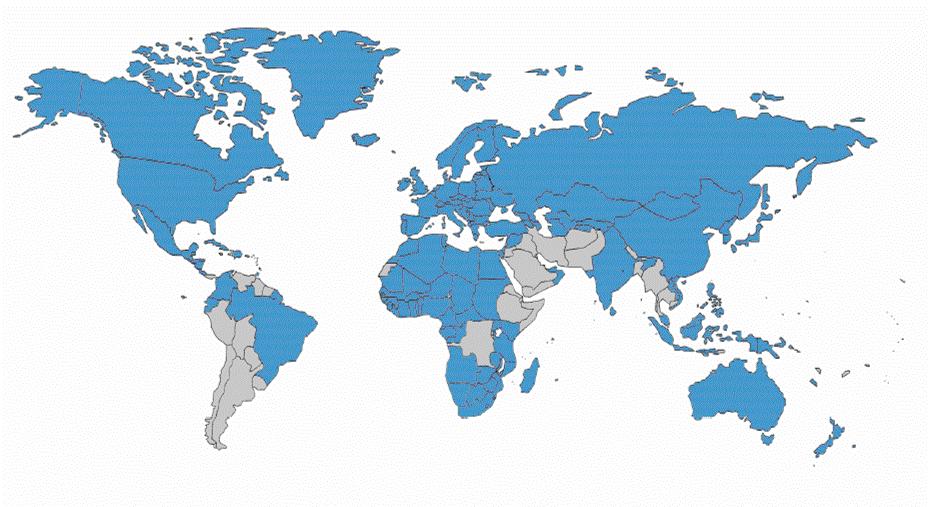
Note:
The list includes all States that have adhered to the PCT by the date indicated in the heading.
Note that even though the filing of a request constitutes under PCT Rule 4.9(a) the designation of all Contracting States bound by the PCT on the international filing date, for the granting of every kind of protection available and, where applicable, for the granting of both regional and national patents, applicants should always use the latest versions of request form (PCT/RO/101) and demand form (PCT/IPEA/401) (the latest versions are dated July 2008) or, if filing the request using the PCT-EASY features of the PCT-SAFE software, use the latest version of this software (which is available at: www.wipo.int/pct-safe). The request and demand forms can be printed from the website in editable PDF format, at: www.wipo.int/pct/en/forms/ or obtained from receiving Offices or the International Bureau or, in the case of the demand form, also from International Preliminary Examining Authorities.
12. MORE RESOURCES ON THE INTERNET
The following patent resources are available on the WIPO Internet:
| PATENTSCOPE® - WIPO's gateway to patent services and activities. | https://www.wipo.int/patentscope/en/ |
| Information on the PCT System | https://www.wipo.int/pct/en/ |
| PATENTSCOPE® search service - Search PCT International Applications and view/download complete patent applications and related documentation. | https://www.wipo.int/pctdb/en/ |
| PCT Statistics - monthly and yearly statistics on the PCT system, including comparative list of applicants and details of the indicators included in this report. | https://www.wipo.int/ipstats/en/statistics/pct/ |
| Law of Patents - includes current and emerging issues related to patents, information on WIPO-administered treaties, access to national/regional patent laws, patent law harmonization. | https://www.wipo.int/patent-law/en/ |
________________________________________
1 See official PCT fee tables [PDF]. Amounts can fluctuate with exchange rates.
2 Regular updates are made at https://www.wipo.int/ipstats/en/
3 Estimate - WIPO continues to receive PCT international applications filed with national Offices in 2008 throughout the first half of the year 2009.
4 Where complete data are available. 2007 figures (2006 for Brazil, 2004 for India) are used for direct filings (i.e. non-PCT resident and non-resident filings) and PCT national phase entries. 2008 PCT international application figures (2007 for Brazil, 2005 for India) are used for the conversion rate from resident filings to PCT international application filings, as resident filings must be converted into PCT international applications within a 12 month time limit. 2006 PCT international application figures (2005 for Brazil, 2003 for India) are used for the conversion rate from PCT international application filings to PCT national phase entries, as IA filings must be converted into PCT national phase entries within 18 months from the PCT international application filing date.
5 An applicant originating from any of the States member to the European Patent Convention (see list in section 11) may choose to first file a patent application at his national Office or at the European Patent Office (In this case, the first filing is not considered as being a resident filing). As a result, the conversion rate from resident filings to PCT international application filings might be higher than would otherwise be expected.
6 List available at: https://www.wipo.int/ipstats/en/statistics/pct/
7 Concordance table available at: https://www.wipo.int/ipstats/en/statistics/patents/
8 Based on PCT international applications filed in 2005
9Transmittal under Rule 19.4 of the PCT Regulations.
10 List of Offices available at: https://www.wipo.int/pctdb/en/nationalphase.jsp
11 https://www.wipo.int/ipstats/en/statistics/patents/
12 https://www.wipo.int/ipstats/en/statistics/patents/xls/ipc_technology.xls
13 If the PCT international application is filed by an applicant who is a natural person and who is a national of and resides in a State whose per capita national income is below 3,000 US dollars (according to the average per capita national income figures used by the United Nations for determining its scale of assessments for the contributions payable for the years 1995, 1996 and 1997).
14 If the PCT international application is filed by an applicant, whether a natural person or not, who is a national of and resides in a State that is classed as a least developed country by the United Nations.
15 See “Statistical Sources” in the Preface
16 See EPC member States in Section 11